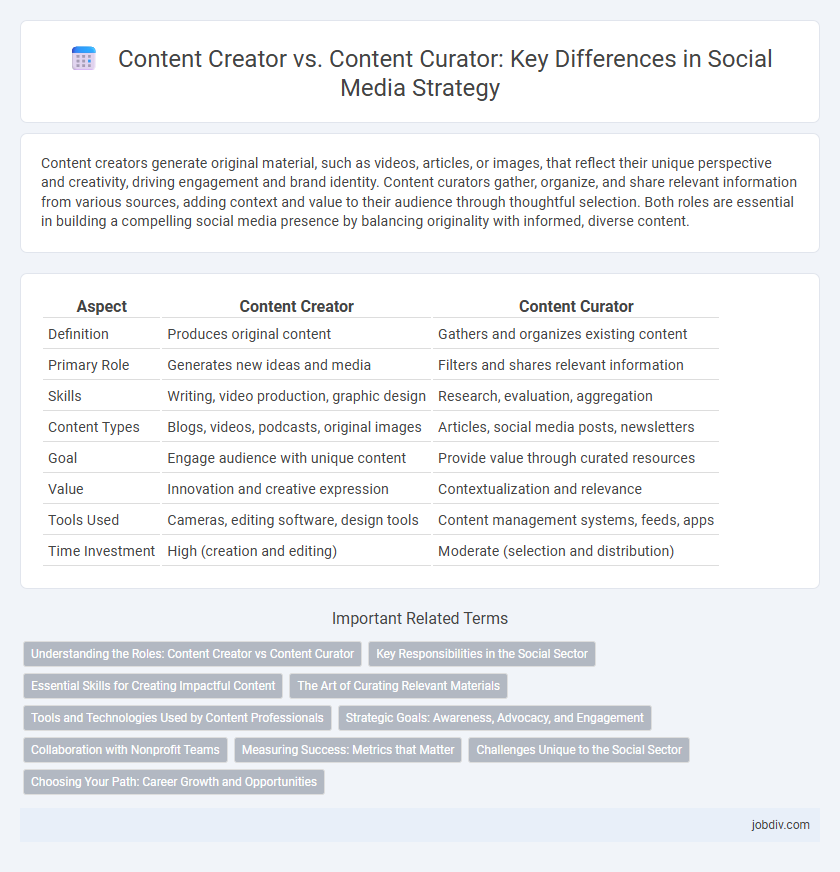Content creators generate original material, such as videos, articles, or images, that reflect their unique perspective and creativity, driving engagement and brand identity. Content curators gather, organize, and share relevant information from various sources, adding context and value to their audience through thoughtful selection. Both roles are essential in building a compelling social media presence by balancing originality with informed, diverse content.
Table of Comparison
| Aspect | Content Creator | Content Curator |
|---|---|---|
| Definition | Produces original content | Gathers and organizes existing content |
| Primary Role | Generates new ideas and media | Filters and shares relevant information |
| Skills | Writing, video production, graphic design | Research, evaluation, aggregation |
| Content Types | Blogs, videos, podcasts, original images | Articles, social media posts, newsletters |
| Goal | Engage audience with unique content | Provide value through curated resources |
| Value | Innovation and creative expression | Contextualization and relevance |
| Tools Used | Cameras, editing software, design tools | Content management systems, feeds, apps |
| Time Investment | High (creation and editing) | Moderate (selection and distribution) |
Understanding the Roles: Content Creator vs Content Curator
Content creators develop original material such as videos, articles, and graphics that engage and inform audiences, driving brand identity and personal expression. Content curators gather, organize, and share relevant content from various sources, adding value through context and commentary to help audiences navigate information overload. Understanding these distinct roles enhances strategic content planning, ensuring a balanced mix of creativity and curation to maximize audience engagement.
Key Responsibilities in the Social Sector
Content creators in the social sector develop original multimedia materials such as videos, blogs, and graphics to engage and inform target audiences. Content curators source, organize, and distribute relevant information from various platforms to maintain consistent and credible messaging. Both roles enhance community engagement but focus on creation versus strategic dissemination of social content.
Essential Skills for Creating Impactful Content
Content creators must excel in originality, storytelling, and multimedia skills to produce engaging and authentic content that captures audience attention. Content curators require expertise in research, critical evaluation, and organization to effectively sift through vast information and present relevant, high-quality material. Both roles demand strong communication abilities and a deep understanding of their target audience to maximize content impact and engagement.
The Art of Curating Relevant Materials
Content curators excel in the art of selecting and organizing relevant materials that align with their audience's interests, enhancing engagement by filtering through vast information to present only high-value content. Unlike content creators who generate original work, curators add value through thoughtful aggregation and contextualization, ensuring the shared content resonates and maintains relevance. Effective curation involves understanding trends, audience preferences, and quality sources to build trust and authority in the digital landscape.
Tools and Technologies Used by Content Professionals
Content creators rely heavily on tools such as Adobe Creative Suite, Final Cut Pro, and Canva to design visually compelling content and edit videos, while curators use platforms like Scoop.it, Feedly, and Pocket to organize and aggregate relevant information efficiently. Artificial intelligence-driven tools, including Grammarly and Lumen5, enhance content creation by automating editing and video production, whereas curators benefit from AI-powered analytics and content recommendation engines to identify trending topics. Both professionals leverage social media management tools like Hootsuite and Buffer to schedule posts and monitor audience engagement, optimizing their digital presence strategically.
Strategic Goals: Awareness, Advocacy, and Engagement
Content creators generate original content tailored to build brand awareness by capturing audience attention with unique storytelling and creative visuals. In contrast, content curators strategically select and share relevant third-party content to foster engagement and strengthen community advocacy through consistent value delivery. Together, creators and curators drive comprehensive social media strategies that enhance brand visibility, deepen audience relationships, and encourage active participation.
Collaboration with Nonprofit Teams
Content creators generate original material tailored to nonprofit campaigns, while content curators gather and organize relevant resources to enhance messaging. Collaboration between these roles enables nonprofit teams to efficiently amplify their impact by blending fresh ideas with well-researched content. This synergy increases audience engagement and supports mission-driven storytelling across multiple platforms.
Measuring Success: Metrics that Matter
Content creators measure success through engagement metrics such as likes, shares, comments, and follower growth, reflecting their original content's impact and audience resonance. Content curators focus on metrics like click-through rates, time spent on curated content, and conversion rates, which indicate the relevance and value of aggregated materials to their audience. Both roles benefit from analyzing audience retention and sentiment analysis to optimize content strategy and maximize influence within social media ecosystems.
Challenges Unique to the Social Sector
Content creators in the social sector face challenges such as generating original, impactful messages that resonate with diverse, often vulnerable audiences while ensuring cultural sensitivity and ethical storytelling. Content curators must navigate the complexity of verifying the credibility of information, avoiding misinformation, and maintaining up-to-date resources that support social causes authentically. Both roles require balancing engagement and trust, with creators focusing on narrative innovation and curators on accurate, meaningful aggregation.
Choosing Your Path: Career Growth and Opportunities
Content creators drive originality by producing unique and engaging materials that build strong personal brands and yield higher monetization possibilities. Content curators excel in filtering and organizing quality information, making them valuable in roles emphasizing efficient knowledge management and audience trust. Evaluating your skills in creativity versus analytical organization helps determine the optimal path for long-term career advancement and industry relevance.
Content Creator vs Content Curator Infographic

 jobdiv.com
jobdiv.com